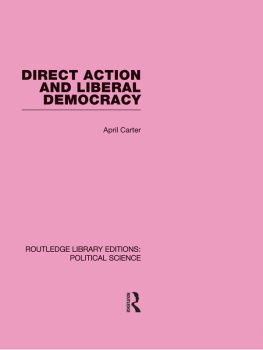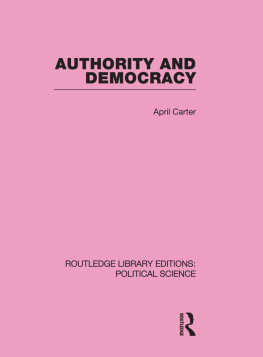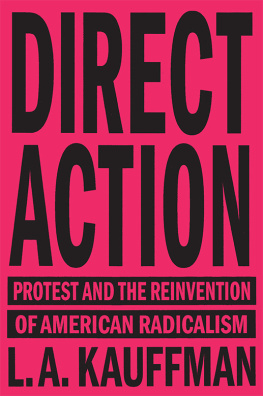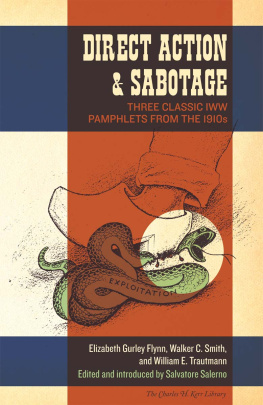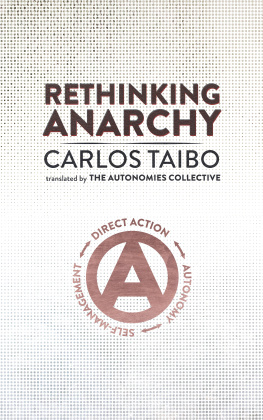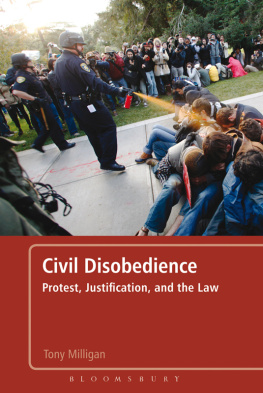ROUTLEDGE LIBRARY EDITIONS: POLITICAL SCIENCE
DIRECT ACTION AND LIBERAL DEMOCRACY
DIRECT ACTION AND LIBERAL DEMOCRACY
By
APRIL CARTER
Volume 6
First published 1973
This edition first published in 2010
by Routledge
2 Park Square, Milton Park, Abingdon, Oxon, OX14 4RN
Simultaneously published in the USA and Canada
by Routledge
270 Madison Avenue, New York, NY 10016
Routledge is an imprint of the Taylor & Francis Group, an informa business
1973 April Carter
All rights reserved. No part of this book may be reprinted or reproduced or utilised in any form or by any electronic, mechanical, or other means, now known or hereafter invented, including photocopying and recording, or in any information storage or retrieval system, without permission in writing from the publishers.
British Library Cataloguing in Publication Data
A catalogue record for this book is available from the British Library
ISBN 10: 0-415-49111-8 (Set)
ISBN 13: 978-0-415-49111-2 (Set)
ISBN 10: 0-415-55536-1 (Volume 6)
ISBN 13: 978-0-415-55536-4 (Volume 6)
Publishers Note
The publisher has gone to great lengths to ensure the quality of this reprint but points out that some imperfections in the original copies may be apparent.
Disclaimer
The publisher has made every effort to trace copyright holders and would welcome correspondence from those they have been unable to trace.
Direct action and liberal democracy
Apirl Carter
First published 1973
by Routledge & Kegan Paul Ltd
Broadway House, 68-74 Carter Lane,
London EC4V 5EL
April Carter 1973
No part of this book may be reproduced in any form without permission from the publisher, except for the quotation of brief passages in criticism
ISBN 0 7100 7594 4 (C)
0 7100 7647 9 (P)
Acknowledgments
My general intellectual debts to past colleagues will be recognized by any of them who read this book, but are too numerous and too diffuse to be acknowledged here. Specifically I am very grateful to Margaret Canovan, Paul Brodetsky and Fay Gadsden for advice on various parts of this book, to Eileen Brock for her help with typing, and to David Hoggett for lending me so many books from the Commonweal postal library.
Introduction
The last two decades show a startling contrast in political styles. In the calm of the apparent political apathy of the 1950s political commentators took for granted the age of liberal consensus and parliamentary compromise. A political and theoretical challenge to the supremacy of this brand of liberalism emerged early in the 1960s. This challenge grew out of the movements against the H-bomb, against racialism and later against the Vietnam war. The broader challenge was developed by the grouping usually called the New Left, which by the mid-1960s began to reject more explicitly the values of liberalism. The alienation of the New Left from western society was both increased and extended by the development of a youth counter culture in the same period.
Any theoretical discussion of the challenge posed to liberal democracy must involve an analysis of the methods adopted by protest movements which have, to a large extent, discarded orthodox liberal styles of political activity for various modes of direct action such as sit-downs, sit-ins, civil disobedience and draft-resistance. The political implications of direct action depend, however, not only on what types of action are taken, but on the aims of the movement and the response of the authorities. Above all, perhaps, the political implications of direct action depend on the precise social context in which it takes placewhether, for example, in the Deep South or in the Ivy League universities.
This book concentrates primarily on examining the nature of the direct action which typified the style of protest movements in the 1960s. Examination of the method is therefore necessarily entwined with the evolution of these movements. But direct action is also treated as a mode of political activity which has a much longer history, and draws on a number of different traditions. It therefore transcends the specific associations of movements like the New Left. And on the evidence available so far, direct action looks as though it may become in the 1970s a method increasingly used by large numbers of people impatient of waiting for the authorities to act on their behalf. If so, it will, as in the past, be an instrument of popular radicalism; and the spread of direct action tactics may be one aspect of the populist mood which seems to be replacing the mainly student dissent of the 1960s.
The later chapters consider some of the liberal arguments against direct action, and the various liberal or democratic justifications for extraconstitutional forms of protest. This discussion does not attempt anything so ambitious as a total critique of western parliamentary democracyor a full discussion of the complex theory of liberalism. Instead, it explores a few limited themes in relation to the role of direct action in a parliamentary system, and the implications of such action for both parliamentary democracy and a liberal society.
1 The Meaning of Direct Action
Direct action is currently a popular but somewhat ambiguous term. It suggests that people are taking to the streets, having abandoned the processes of discreet lobbying in the corridors of power. But a conventional march through the streets of Londonwhich has become a standard pressure group tacticwould not today count as direct action, since direct action is associated with sit-downs and arrests, or with violent confrontations with the police.
Direct action cannot, however, be defined solely in terms of the methods used. It depends also on the political context and on the mood surrounding the event. Holding a march in defiance of a banning order, or as a form of demonstration in a situation of mass unrest, might well constitute direct action.
The purposes of direct action are also extremely varied. It may involve an attempt to assert what are regarded as basic constitutional rightsfor instance, holding a meeting. It may be a more dramatic substitute for lobbying the government, but have the same goal: to bring pressure to bear in order to attain a limited and specific reform. It may be designed to demonstrate in action the answer to a particular problemhomeless families squatting in empty council houses, for example. It may be primarily a symbolic act of protest or solidarity in relation to a wider struggle, for instance, a boycott of South African goods. Or it may be a method used to repudiate the entire political system and promote insurrection.
Strict definition of direct action in terms of method, goal, or of the persons using it is likely to become sterile and misleading. But if it is not to shade off into meaninglessness, it must be distinguished from constitutional and parliamentary styles of activity on the one hand, and from guerrilla warfare on the other. Neither is direct action simply a synonym for protest or for violence, though it is closely associated with protest movements, and may result, unintentionally or intentionally, in some forms of violence.
The most illuminating approach to an understanding of what is entailed in the idea of direct action is to consider which movements have consciously used direct action, and what theoretical connotations surround their use of the phrase. This chapter therefore draws on the writings of advocates of direct action, and on studies of particular direct-action campaigns.

